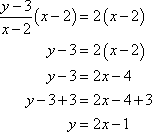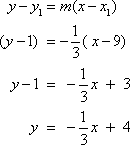 username@email.com
username@email.com
In this lesson, we will study how to find the equation of a line.
The slope of a line indicates how steep it is. To locate a line on a coordinate plane, however, we must know at least one point on the line as well as the line’s slope.
Remember that the y-intercept is the value of y where the line crosses the y-axis. In other words, it is the value of y where x = 0. In the slope-intercept form of an equation, b is the y-intercept. Therefore, if we know the slope and the y-intercept, we are able to find equation of the line in slope-intercept form.
For example, we know a line contains the point (2, 3) and has a slope of 2. By plugging the slope into slope-intercept form we find that y = 2x + b.
Graph the point (2, 3). From there, move 2 units up and 1 unit right to find a second point.
In effect, we have substituted the values from the point we know into the slope formula.

Then multiply both sides of the equation by (x – 2) and simplify to solve for y.

We now have the slope-intercept form of the equation, which was simplified from point-slope form of the equation in step two above. To generalize point-slope form, the equation of a line through a point (x1, y1) is ![]() ,where m is the slope.
,where m is the slope.
If you know the x– and y-intercepts, substitute the values of those points into the formula for slope.
![]()
Then substitute the slope into slope-intercept form.
For example, given the points (12, 0) and (9, 1), find the equation of the line in point-slope form.
First, use the two points given to find the slope.

Then substitute the values of one point and the slope into the equation ![]() .
.

The slope is ![]() and the y-intercept is (0, 4).
and the y-intercept is (0, 4).
Algebra Demystified: A Self-teaching Guide (Rhonda Huettenmueller): McGraw-Hill, 2003.
College Algebra (Ron Larson and Robert P. Hostetler): Houghton Mifflin, 2003.
Practical Algebra: A Self-Teaching Guide (Peter H. Selby and Steve Slavin): John Wiley and Sons, 1991.
Schaum’s Outline of Intermediate Algebra (Ray Steege and Kerry Bailey): McGraw Hill, 1997.
Don’t forget to test your knowledge with the Algebra and Functions I Chapter Quiz;